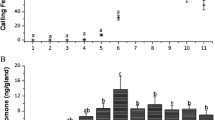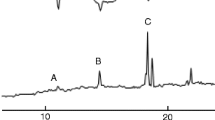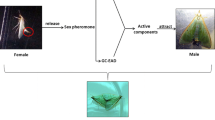Abstract
Analysis of female abdominal tips ofAgrotis segetum by means of GC-MS showed the presence of 13 aliphatic acetates and alcohols. (Z)-7-Dodecenyl acetate was found to be the main component in the extracts at amounts of about 1 ng/female. (Z)-9-Tetradecenyl acetate and (Z)-7-dodecenol were present to the extent of 49 and 19%, respectively, of the main component. Minor components could be identified as decyl acetate, (Z)-5-decenyl acetate, dodecyl acetate, (Z)-9-dodecenyl acetate, tetradecyl acetate, a tetradecenyl acetate, hexadecyl acetate, a hexadecenyl acetate, (Z)-5-decenol, and (Z)-9-tetradecenol. The presence and biological activity of decyl acetate, (Z)-5-decenyl acetate, and (Z)-7-dodecenyl acetate in the extracts could be detected by GC-EAD. Tested by EAG (Z)-5-decenyl acetate evoked the highest response among pheromone candidates, followed by (E)-5-decenyl acetate and (Z)-7-dodecenyl acetate. Single-cell recordings from 100 male antennal sensilla trichodea revealed receptorcells highly sensitive to (Z)-5-decenyl, (Z)-7-dodecenyl, (Z)-8-dodecenyl, and (Z)-9-tetradecenyl acetate as well as (Z)-5-decenol. The (Z)-5-decenyl, (Z)-7-dodecenyl, and (Z)-9-tetradecenyl acetate receptors were activated significantly also by female extracts. When tested in a tube olfactometer, a blend of decyl, (Z)-5-decenyl, (Z)-7-dodecenyl, and (Z)-9-tetradecenyl acetate evoked the same male response as did female glands.
Tested in the field, this blend was more attractive than virgin females. Other authors previously reported many of the compounds identified in the present study. However, both quantitative and qualitative discrepancies exist among the various investigations, possibly due to the existence of geographical races.
Similar content being viewed by others
References
Arn, H., Stadler, E., andRauscher, S. 1975. The electroantennographic detector—a selective and sensitive tool in the gas Chromatographic analysis of insect pheromonesZ.Naturforsch. 30c:722–725.
Arn, H., Städler, E., Rauscher, S., Buser, H.R., Mustaparta, H., Esbjerg, P., Philipsen, H., Zethner, O., Struble, D.L., andBues, R. 1980. Multicomponent sex pheromone inAgrotis segetum: Preliminary analysis and field evaluation.Z. tNaturforsch. 35c:986–989.
Baker, T.C., Cardé, R.T., andRoelofs, W.L. 1976. Behavioral responses of maleArgyrotaenia velutinana (Lepidoptera: Tortricidae) to components of its sex pheromone.J. Chem. Ecol. 2:333–352.
Beroza, M., andBierl ,B.A. 1967. Rapid determination of olefin position in organic compounds in the microgram range by ozonolysis and gas chromatography.Anal. Chem. 39:1131–1135.
Bestmann, H.J., Vostrowsky, O., Koschatzky, K.H., Platz, H., Brosche, T., Kantardjiew, I., Rheinwald, M., andKnauf, W. 1978. (Z)-5-Decenylacetate, ein Sexuallockstoff für Männchen der SaateuleAgrotis segetum (Lepidoptera).Angew. Chem. 90:815–816.
Bestmann, H.J., Brosche, T., Koschatzky, K.H., Michaelis, K., Platz, H., andVostrowsky, O. 1980. Pheromone XXX, Identifizierung eines neuartigen Pheromone Komplexes aus der GrasculeScotia exclamationis (Lepidoptera).Tetrahedron Lett. 21:747–750.
Den Otter, C.J. 1977. Single sensillum responses in the male mothAdoxophyes orana (F.v.R.) to female sex pheromone components and their geometrical isomers.J. Comp. Physiol. 121:205–222.
Grob, K., andZürcher, F. 1976. Stripping of organic trace substances from water. Equipment and procedure.J. Chromatogr. 117:285–294.
Hill, A.S., Rings, R.W., Swier, S.R., andRoelofs, W.L. 1979. Sex pheromone of the black cutworm moth,Agrotis ipsilon. J. Chem. Ecol. 5:439–457.
Hinks, C.F., andByers, J.R. 1976. Biosystematics of the genuseuxoa (Lepidoptera: Noctuidae) V. Rearing procedures and life cycles of 36 species.Can. Entomol. 108:1345–1357.
Houx, N.W.H., Voerman, S., andJongen, W.M.F. 1974. Purification and analysis of synthetic insect sex attractants by liquid chromatography on a silver-loaded resin.J. Chromatogr. 96:25–32.
Kärnestam, E. 1979. A new method of forecasting the number of cutworms.Vaxtskyddsnotiser 43:32–33.
Otto, D., Pilz, R., andBehnisch, I. 1976. Sexualpheromon—Nachweis bei den beiden NoctuidenAgrotis (Scotia)segetum Schiff, undMamestra (Barathra)brassicae L.Arch. Phytopathol. Pflazenschutz 12:197–212.
Roelofs, W.L., andCardé, R.T. 1977. Response of Lepidoptera to synthetic sex pheromone chemicals and their analogues.Annu. Rev. Entomol. 22:377–405.
Roelofs, W., Hill, A., Cardé, R., Tette, J., Madsen, H., andVakenti, J. 1974. Sex pheromones of the fruitree leafroller moth,Archips argyrospilus.Environ. Entomol, 3:747–751.
Roelofs, W., Hill, A., andCarde, R. 1975. Sex pheromone components of the redbanded leafroller.Argyrotaenia velutinana (Lepidoptera: Tortricidae).J. Chem. Ecol. 1:83–89.
Siegel, S. 1956. Nonparametric Statistics for the Behavioral Sciences. McGraw-Hill, New York.
Silverstein, R.M., andYoung, J.C. 1976. Insects generally use multicomponent pheromones, pp. 1–29,in M. Beroza (ed.). Prospects for Insect Pest Management with Sex Attractants and Other Behavior-Controlling Chemicals. American Chemical Society, Washington, ACS Symposium Series No.23.
Sokal, R.R., andRohlf, F.J. 1969. Biometry. W.H. Freeman and Company, San Francisco.
Sower, L.L., Vick, K.W., andLong, J.S. 1973. Isolation and preliminary biological studies of the female-produced sex pheromone ofSitotroga cerealella (Lepidoptera: Gelechiidae).Ann. Entomol. Soc. Am. 66:184–187.
Steck, W.F., Underhill, E.W., Chisholm, M.D., andByers, J.R. 1979. Sex attractants forAgrotis venerabilis andEuxoa albipennis based on (Z)-5-decenyl acetate and (Z)-7-dodecenyl acetate.Environ. Entomol. 8:1126–1128.
Struble, D.L., andSwailes, G.E. 1978. A sex attractant for adult males of the pale western cutworm,Agrotis orthogonia (Lepidoptera: Noctuidae).Can. Entomol. 110:769–773.
Tamaki, Y. 1979. Multi-component sex pheromone of Lepidoptera with special reference toAdoxophyes sp., pp. 169–180,in F.J. Ritter (ed.). Chemical Ecology: Odour Communication in Animals. Elsevier/North-Holland Biomedical Press, Amsterdam.
Toth, M., Jakab, J., andNovák, L. 1980. Identification of two components from the sex pheromone system of the white-line dart moth,Scotia segetum (Schiff.) (Lep., Noctuidae).Z. Angew. Entomol. 90:505–510.
Van Der Pers, J.N.C. 1981. Comparison of electroantennogram response spectra to plant volatiles in seven species ofYponomeuta and in the tortricidAdoxophyes orana.Entomol. Exp. Appl. 30:181–192.
Van Der Pers, J.N.C., andDen Otter, C.J. 1978. Single-cell responses from olfactory receptors of small ermine moths to sex attractants.J. Insect. Physiol. 24:337–343.
Wakamura, S. 1978. Sex attractant pheromone of the common cutworm moth,Agrotis fucosa (Butler) (Lepidoptera: Noctuidae): Isolation and identification.Appl. Entomol. Zool. 13:290–295.
Wakamura, S. 1980. Sex attractant pheromone of the common cutworm mothAgrotis fucosa (Butler): Field evaluation.Appl. Entomol. Zool. 15:167–174.
Author information
Authors and Affiliations
Additional information
Schiff., Lepidoptera: Noctuidae.
This study was made within the Swedish project “Odour Signals for Control of Pest Insects.”
Rights and permissions
About this article
Cite this article
Löfstedt, C., Van Der Pers, J.N.C., Lofqvist, J. et al. Sex pheromone components of the turnip moth,Agrotis segetum . J Chem Ecol 8, 1305–1321 (1982). https://doi.org/10.1007/BF00987764
Received:
Revised:
Issue Date:
DOI: https://doi.org/10.1007/BF00987764




